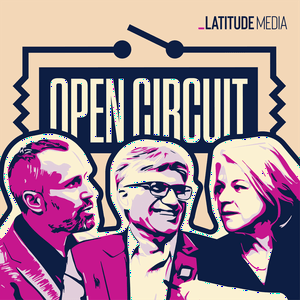Episodios disponibles
5 de 43
- The year's twists, villains, and breakout stars in energyThis year, the energy industry changed faster than we could talk about it. We collectively said more than 225,000 words on this show — some of them were informed takes, some speculation. So how did they age? This week, Stephen reaches into a stocking stuffed with quotes from past episodes, and Jigar and Katherine must decide to defend, update, or disown their own words. Then, we honor the storylines and surprises that defined the year. The categories include: The biggest plot twist The breakout star The best villain The most underrated storyline Finally, we look ahead and make one bold prediction for 2030. In a year of growth, uncertainty, and a bit of existential dread, join us for our recap of the last 12 months. Fill out our listener survey for a chance to win a $100 gift card! Nextracker is now Nextpower. As electricity demand surges with AI, data centers and electrified infrastructure, solar is the only power source that can scale fast enough to meet this moment. Nextpower is the technology platform built for this future, delivering connected systems that unify the structural, electrical and digital technologies of a solar power plant. Powering what’s next at Nextpower.com. Open Circuit is brought to you by Natural Power. Natural Power specializes in renewable energy consulting and engineering, supporting wind, solar, and battery storage projects from concept through financing. Discover how we're creating a world powered by renewable energy at naturalpower.com.--------1:13:29
- 3 years after ChatGPT, vibes meet grid realitiesThree years after ChatGPT ignited the AI race, the assumptions driving the trillion-dollar data-center boom are starting to shift. The belief that endlessly scaling large language models will unlock AGI — and justify unprecedented growth in electricity demand — is now being questioned by some of the field’s most influential voices. At the same time, utilities are planning roughly a trillion dollars in grid upgrades, much of it based on speculative data-center proposals and a still-evolving understanding of real load. In this episode, Stephen Lacey unpacks the growing tension between an AI industry defined by rapid iteration and a power system built on decades-long investment cycles. What does that mismatch mean for forecasting, financing, and resource planning? We then feature two conversations from Transition-AI Boston. Former FERC commissioner Allison Clements and Generate Capital’s Peter Nulsen explain why traditional planning signals no longer offer the certainty they once did. How do load uncertainty, short-term contracts, and sequencing challenges reshape the risk profile for new energy projects? In the second discussion, Mike Kramer of Constellation, Dawn Owens of Fervo Energy, and Sam Simmons of Form Energy explore whether AI-driven load will create meaningful demand signals for clean, firm technologies like geothermal, advanced nuclear, and multi-day storage. What will determine if they gain a real foothold? We will soon be opening registration for Transition-AI 2026 in San Francisco. More details here. Nextracker is now Nextpower. As electricity demand surges with AI, data centers and electrified infrastructure, solar is the only power source that can scale fast enough to meet this moment. Nextpower is the technology platform built for this future, delivering connected systems that unify the structural, electrical and digital technologies of a solar power plant. Powering what’s next at Nextpower.com. Open Circuit is brought to you by Natural Power. Natural Power specializes in renewable energy consulting and engineering, supporting wind, solar, and battery storage projects from concept through financing. Discover how we're creating a world powered by renewable energy at naturalpower.com. With resilience now a leading driver of grid investments, Latitude Media and The Ad Hoc Group are hosting the Power Resilience Forum in Houston, Texas on January 21-23, 2026. Utilities, regulators, innovators, and investors will all be in the room — talking about how to keep the grid running in this new era of heatwaves, wildfires, and storms. Register today here!--------51:37
- A feast of hot takesThis year in energy has had the vibes of a dysfunctional family gathering: everyone showed up with big feelings, and no one agreed on the menu. To celebrate Thanksgiving, we’re processing the chaos right at the dinner table. In this holiday special, the team matches classic Thanksgiving guest archetypes with the biggest energy storylines of 2025. Who is the drunk uncle sucking up all the oxygen in the room? Who is the pragmatic parent holding the family together? And who is the rebellious teenager threatening to upend the status quo? But first, we serve an appetizer of the week’s biggest news: a new analysis from Grid Strategies shows that projected peak load growth has quadrupled in just two years to 166 GW. And we’ll wrap with leftovers — the unfinished stories we’ll be sharing well into next year. Fill out our listener survey for a chance to win a $100 gift card! Nextracker is now Nextpower. As electricity demand surges with AI, data centers and electrified infrastructure, solar is the only power source that can scale fast enough to meet this moment. Nextpower is the technology platform built for this future, delivering connected systems that unify the structural, electrical and digital technologies of a solar power plant. Powering what’s next at Nextpower.com. Open Circuit is brought to you by Natural Power. Natural Power specializes in renewable energy consulting and engineering, supporting wind, solar, and battery storage projects from concept through financing. Discover how we're creating a world powered by renewable energy at naturalpower.com. With resilience now a leading driver of grid investments, Latitude Media and The Ad Hoc Group are hosting the Power Resilience Forum in Houston, Texas on January 21-23, 2026. Utilities, regulators, innovators, and investors will all be in the room — talking about how to keep the grid running in this new era of heatwaves, wildfires, and storms. Register today here!--------1:03:00
- The grid resilience dilemmaUtilities are facing a collision of pressures: extreme weather, rising load, affordability concerns, and growing regulatory friction. Everyone agrees the grid needs to be hardened. But the real question is: how much resilience should we pay for? On one side, utilities are confronting unprecedented stress from storms, wildfires, flooding, and heat. On the other, they’re under pressure from regulators and customers to keep rates down — even as costs spike from inflation, supply chain delays, and long-overdue modernization. The Edison Electric Institute estimates that utilities are planning about a trillion dollars in grid investment by 2030. But how much of that is truly focused on resilience? And how do we balance the need for those investments with all the other cost pressures hitting the system? This week, we’re joined by Julia Hamm, a partner with the Ad Hoc Group, to break down where resilience fits in. We look at how utilities justify resilience spending, how regulators are responding, and why so much of the debate comes down to defining the line between reliability, resilience, and routine maintenance. Then we widen the lens to the emerging resilience-tech market, a growing ecosystem of startups focused on wildfire detection, predictive weather analytics, vegetation management, sensors, and advanced grid modeling. We explore how these technologies could help utilities target investments and turn resilience into opportunity rather than pure cost. Fill out our listener survey for a chance to win a $100 gift card! Open Circuit is brought to you by Natural Power. Natural Power specializes in renewable energy consulting and engineering, supporting wind, solar, and battery storage projects from concept through financing. Discover how we're creating a world powered by renewable energy at naturalpower.com. With resilience now a leading driver of grid investments, Latitude Media and The Ad Hoc Group are hosting the Power Resilience Forum in Houston, Texas on January 21-23, 2026. Utilities, regulators, innovators, and investors will all be in the room — talking about how to keep the grid running in this new era of heatwaves, wildfires, and storms. Register today here!--------1:01:10
- Bill Gates caused a climate meltdownAfter Bill Gates dropped a new climate manifesto, the internet did what it always does: lost its mind. Conservatives claimed victory, progressives accused him of selling out, and somewhere in the middle was a real debate about how the energy transition actually happens. This week, in our episode recorded live at Greentown Labs, we’re jumping into the fray. What does the debate say about the state of climate tech in 2025? We’ll start with a look at the debate over Bill Gates’ latest letter on climate impacts, philanthropy, and tech progress. Why does he obsess over innovation while ignoring the systems that help solutions scale? Then we turn to the so-called “new normal” for climate tech capital. Venture investment is thawing, public markets have rebounded, and infrastructure money is pouring into the sector. What does that mean for startups? Finally, we end with a little thought experiment about what history will remember us for. Open Circuit is brought to you by Natural Power. Natural Power specializes in renewable energy consulting and engineering, supporting wind, solar, and battery storage projects from concept through financing. Discover how we're creating a world powered by renewable energy at naturalpower.com. With resilience now a leading driver of grid investments, Latitude Media and The Ad Hoc Group are hosting the Power Resilience Forum in Houston, Texas on January 21-23, 2026. Utilities, regulators, innovators, and investors will all be in the room — talking about how to keep the grid running in this new era of heatwaves, wildfires, and storms. Register today here!--------49:11
Más podcasts de Noticias
Podcasts a la moda de Noticias
Acerca de Open Circuit
The energy transition, decoded. Every week, three industry veterans explore the tech breakthroughs, market shakeups, and policy shifts that are driving the biggest industrial transformation in history.
Sitio web del podcastEscucha Open Circuit, The Daily y muchos más podcasts de todo el mundo con la aplicación de radio.net

Descarga la app gratuita: radio.net
- Añadir radios y podcasts a favoritos
- Transmisión por Wi-Fi y Bluetooth
- Carplay & Android Auto compatible
- Muchas otras funciones de la app
Descarga la app gratuita: radio.net
- Añadir radios y podcasts a favoritos
- Transmisión por Wi-Fi y Bluetooth
- Carplay & Android Auto compatible
- Muchas otras funciones de la app


Open Circuit
Escanea el código,
Descarga la app,
Escucha.
Descarga la app,
Escucha.



































